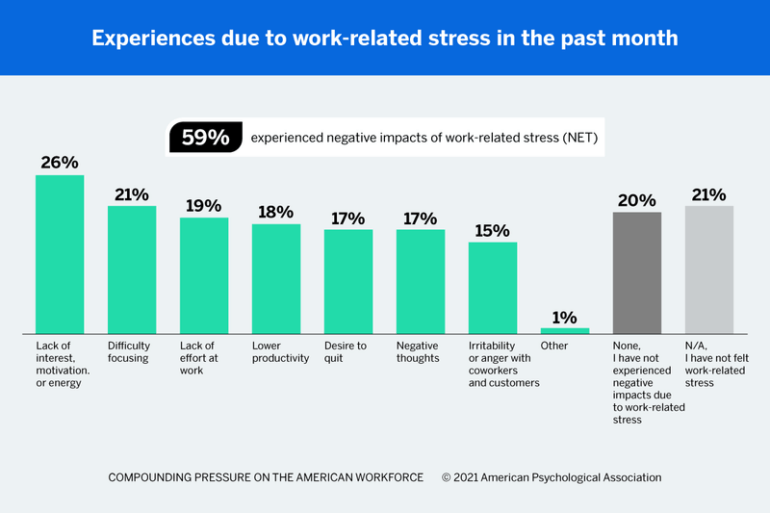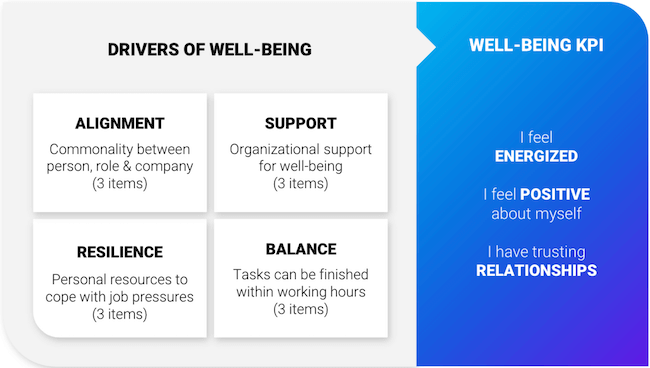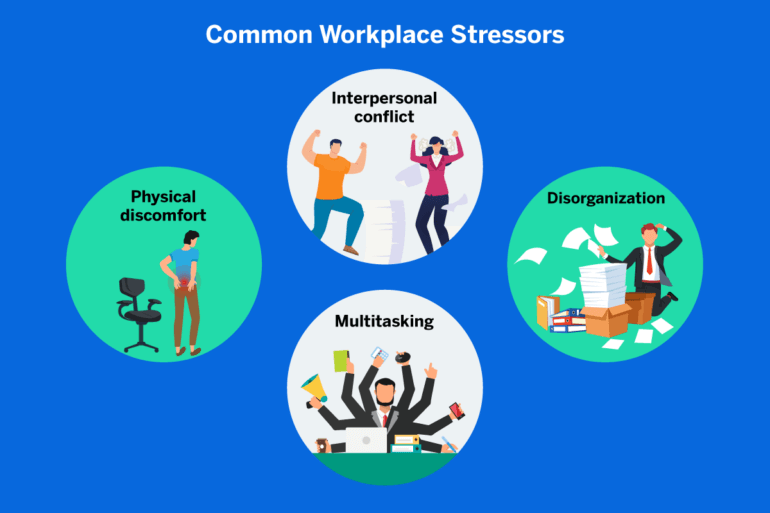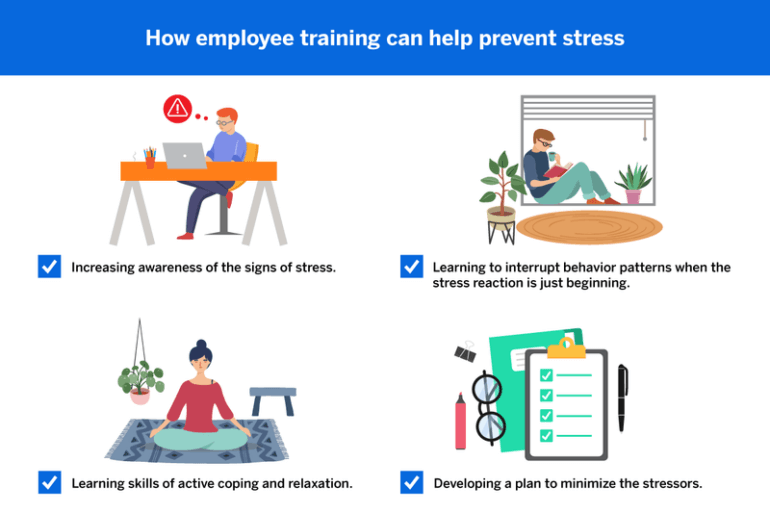
Employee Experience
Your guide to stress management at work
How can business leaders manage workplace stress? What better way to do this than by creating a work environment and company culture that avoids stress altogether? Here’s what you need to know.
US employees are among the most stressed in the world, according to a report by Gallup. It finds that 57% of Americans and Canadians say they feel stress every day, compared with 43% of other global employees. As well as the detrimental effects on employees as individuals, workplace stress has negative consequences for businesses:
- High absentee rate
- High employee turnover
- Poor timekeeping
- Poor performance
- Poor productivity
- Low morale
- Poor motivation
- Increased negative employee feedback
- Increased illness, accidents, and incidents
Gauge your employees' satisfaction with our free Employee Satisfaction Survey

And according to our Employee Experience Trends report, employee well being, with stress reduction management at its core, has incredibly positive implications for a business:
- A 21% increase in employee productivity
- 4x greater organizational profitability
- 68% of senior leaders ranked employee well-being as a top priority
(Qualtrics 2022 Trends Report, November 2022)
So, when stress has such negative effects when it gets out of control, but employee well-being delivers such positive benefits, it makes sound business sense to invest heavily in effective stress relief solutions.
What is workplace stress?
Workplace stress is defined as: ‘the harmful physical and emotional responses that can happen when there is a conflict between job demands on the employee and the amount of control an employee has over meeting these demands’.
The stress can result from just one factor or many. Problems occur when employees cannot handle their stress levels, and these begin to take a mental health and/or physical toll, even leading to serious illness.
Sources of workplace stress
There are six major workplace stressors that, if not properly managed, can affect employee stress response. They are:
- Demands – employees struggle to cope with their job demands, often with poor resources, and in an uncomfortable environment
- Control – employees are unable to control how they do their jobs, are micromanaged, or expected to multitask
- Support – lack of managerial job support or relevant information can cause chronic stress
- Relationships – lack of team cohesion, bullying, interpersonal conflict, or tricky work relationships
- Role – not understanding their role or responsibilities fully, and being disorganized, or lacking time management skills, as a result
- Change – lack of information, engagement, or inclusion during a time of change
Signs of workplace stress
When you notice employees beginning to act differently, this should be a red flag that something may be wrong and that something may be workplace stress. It’s then your responsibility as an employer to act to protect your employees.
Stress symptoms within teams
There may be obvious signs of stress, such as co-workers arguing with each other, or an uptick in complaints and grievances that may cite stress as a problem. Team members may take more time off sick, transfer out of the team, or even leave the company. And if the only obvious sign is decreased performance, that could be stressed teams trying to make the best of their situation, yet not being able to deliver their best work.
Stress symptoms in an individual employee
A stressed employee may feel overwhelmed and demonstrate changes in mood or behavior, such as becoming more withdrawn, or more emotional: unusually sensitive, tearful, anxious, or aggressive. Physically, they may experience raised blood pressure as part of the fight or flight response that negative stress induces. They may become less confident and lose motivation and commitment to the job, taking more time off work and perhaps showing up late or leaving early. They may also make costly mistakes due to excessive stress.
Why you should care about stress management
Nobody enjoys working in a pressurized environment. The post-pandemic hybrid working culture that is becoming the new normal means that many people will no longer tolerate stressful working conditions – they’ll simply walk, and go to a more enlightened employer. When you manage stress in the workplace well, or, even better, create an environment that is low stress, or avoids it altogether, everyone benefits:
The company culture strengthens
Employees make or break your company culture. When they are mentally and physically healthier and happier, they inject a positive attitude and energy into the workplace, creating a strong culture where creativity, innovation, and productivity thrive.
Fewer people go off sick
Research shows that 1 million Americans miss work each day due to stress, and depression-induced absenteeism costs US businesses $51 billion a year, with $26 billion in treatment costs. And stress-related illnesses such as burnout also cost an estimated $200 to $300 billion a year in lost productivity. Stress management is not only good for your people, it’s good for your bottom line too.
You attract and retain great people
It’s far cheaper to retain your employees than it is to recruit new ones. Employees who love their jobs and don’t suffer from unmanageable stress are more likely to remain at your company and say good things about it to others. Prospective top talent will hear what a great, low-stress company you run and want to join its ranks.
Related: 9 employee retention strategies that work
Teamwork just works
Teams of relaxed employees who feel safe, secure, and that they belong, do a good job. They trust each other, feel they can speak and share information safely and support one another.
It shows you’re an employer who cares
When employees feel they are valued, that their company cares about their well-being, and offers support whenever it’s needed, this is perceived organizational support (POS). POS has important consequences for employee engagement, well-being, and performance. Employees of a business with great POS are more committed, interested, and engaged, less stressed, absent or late, and less inclined to leave.
Stress management techniques
Managers have a responsibility to ensure their teams’ well-being, and manage stress, especially in times of change. You want your employees to thrive at work and look forward to their day and working with their colleagues. Here are some ways to make sure you achieve that:
Create a workplace culture of belonging
This is the gold standard for stress management. And now, belonging is the top employee experience driver linked to engagement and well-being. In the same way that a loving family makes all the stress go away, being in a workplace where you feel you belong, and with colleagues you get on with, is a haven from workplace pressure. Companies can foster a culture of belonging by:
- Demonstrating corporate social responsibility that everyone can be proud of
- Communicating openly and honestly
- Making every member of the team feel valued
- Supporting everyone through change and helping them to adapt
- Encouraging everyone to be their authentic selves at work
- Ensuring everyone can succeed to their full potential, whoever they are
- Listening to employees
- Demonstrating you care about your employees with actions, not just words
Check in on your people – then act
While you’re working towards a complete culture of belonging, you need to get as much real-time information about what is causing your employees to feel stressed at work. Pulse surveys are a great way to do this – you can ping around a survey to ask a targeted question about stress and get the results immediately, so you can do your managerial duty and step in to remove the causes of stress.
Stress management training
It is possible to prevent stress through employee training, although you should be creating a work culture that stops stress in its tracks before it can take hold in your teams. The best positive psychology training teaches employees to be: aware of the signs of stress; change behavior to interrupt the stress reaction before it takes hold; learn relaxation and coping techniques, and make a plan that minimizes the causes of stress.
Self-help stress management tips
Not every company is enlightened enough to be able to deliver a zero-stress workplace. When this is the case, employees will need to employ some of these stress management techniques:
- Workload: communicate with a manager if it seems overwhelming
- Multitasking: don’t! When you try and do too many things at once you lose focus and everything takes twice as long
- Reward yourself for work well done, and take some time out to appreciate your achievements
- Reclaim your time if you went above and beyond after hours to get a job done
- Nothing is perfect - good enough is often as good as it gets, and that’s fine
- Take breaks throughout the day: ideally with some time outdoors and a decent lunch break
- Shut up shop at the end of the day: tidy your workspace, note down tasks for tomorrow, close down your tech and step away from work
- Take all your holiday entitlement: time away from work can really relieve stress and refresh, as well as increase productivity
- Nurture life outside work: treasure friends and family, and have pastimes and interests that have nothing to do with your job
- Have a healthy diet and exercise regularly - these two things that your doctor tells you to do will help reduce stress
How Qualtrics WellBeing At Work can help

Our new Wellbeing at Work solution provides a framework for organizations and individuals to understand the current state of employee well-being, with suggested actions for improvement. It works on the principle that for an employee to experience well being (the state of complete physical, mental and social health) they need to feel:
- Energized
- Positive about themselves
- They have trusting relationships
There are four drivers of well being that we measure:
- Alignment: A sense of belonging, and that employees are able to perform in their roles, providing a sense of purpose, fulfillment, and meaning
- Support: The availability of resources and supportive relationships, which are key in managing stress and health in general
- Resilience: The availability of processes and/or personal strategies that help combat stress
- Balance: When the demands and pressures of a job are out of balance, this can be associated with negative health outcomes, such as chronic stress and burnout
With Qualtrics WellBeing at Work, you have the tools to listen to your employees, gauge whenever their well-being goes out of kilter, and act immediately so you can strive towards the nirvana of a zero-stress workplace.
Discover how Qualtrics WellBeing at Work can lower your employees' stress

